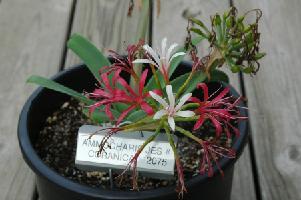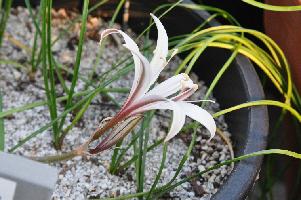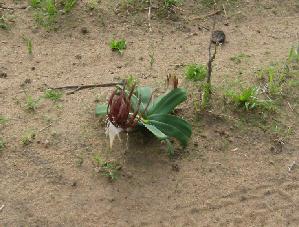


Checklist of the genus Ammocharis.
Culture
These plants can grow in partial shade to full sun.
They seem to prefer growing in large pots; I have most of mine in 8-inch or 10-inch round plastic pots planted in a gritty mix.
Feed with a dilute soluble fertilize when the plant is in active growth. This depends on the species. For summer-growing and opportunistic plants, this will be from late winter or early spring onwards. In late summer, stop feeding. In winter, reduce watering or cease watering completely.
For winter-growing species, grow in protected spot away from frost. Water from early autumn on until growth slows or stops in Spring.
Not frost-hardy, so protect from freezing.
Acknowledgements
Most of the information here is from:D.A. Snijman and H. Kollberg, "Ammocharis deserticola (Amaryllideae) A New Species from Namibia and a Key to the Genus." BOTHALIA vol. 41, No. 2, pp. 308-311 (2011).
Other Sources of Information
Bjørnstad, I.N & Friis, I. (Friis, I. & Nordal, I.)1972-1976. Studies on the
genus Haemanthus L. (Amaryllidaceae) I--IV. Norw. J. Bot. 19: 187--206; 19:
207--222; 21: 243--275; 23: 63--77. The last reference providing keys to the
species, list of synonyms, and necessary combinations.
Bulbous Plants of Southern Africa, Neil du Plessis and Graham Duncan, Tafelberg Pub. Ltd., Cape Town (1989).
Bulbs for Warm Climates, Thad M. Howard, University of Texas Press, Austin (2001).
Bulbs, Revised Edition, John E. Bryan, Timber Press, Portland (2002).
Cape Bulbs, Richard L. Doutt, Timber Press, Portland, Portland (1994).
RHS Manual of Bulbs, John Bryan and Mark Griffiths, Eds., Timber Press, Portland (1995).
The Color Encyclopedia of Cape Bulbs, John Manning, Peter Goldblatt, and Dee Snijman, Timber Press, Portland (2002).



Acknowledgements
For information about this account, contact: James E. Shields, shieldsgardens@gmail.com Last revised: 22 July 2013
© Copyright 2013 by James E. Shields. All rights reserved.